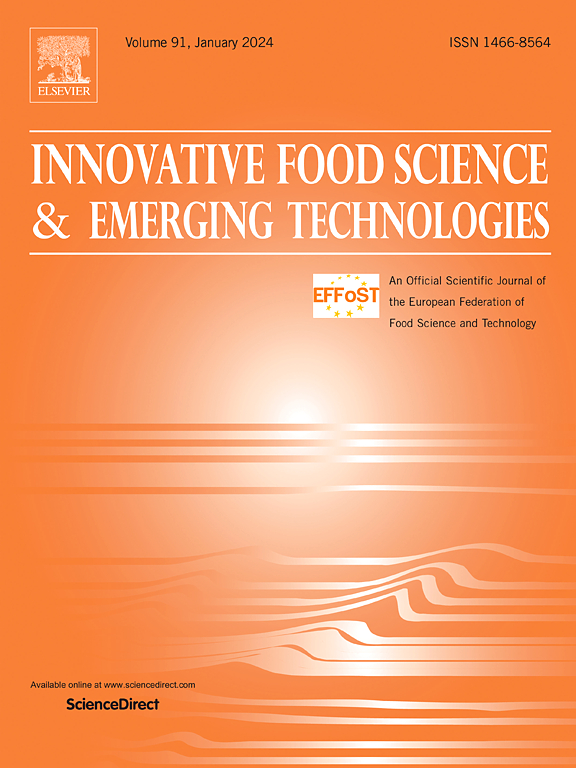蟋蟀分离物作为设计蛋白质食品的成分:功能、结构和界面特性
IF 6.3
1区 农林科学
Q1 FOOD SCIENCE & TECHNOLOGY
Innovative Food Science & Emerging Technologies
Pub Date : 2025-03-28
DOI:10.1016/j.ifset.2025.104013
引用次数: 0
摘要
世界人口的不断增长导致对富含蛋白质的食物的需求增加。这促进了对具有良好氨基酸谱的新型合适蛋白质的不断研究。本研究评估了一种商品蟋蟀(Acheta Domesticus)蛋白粉(蛋白质含量为69.4% w/w)的功能和界面特性。采用超临界CO2和己烷萃取法对粗粉进行脱脂。两种方法都是有效的,提取率相近(接近80%)。通过在双蒸馏水中溶解原料或脱脂粉制备蛋白质溶液,并用于评估等电点(pH值在4至4.4之间),溶解度(pH值接近11时观察到的最高值,即80%)和界面性质。采用垂滴法,对空气/水和水/油界面的界面张力进行了评估。在两个界面处的测量显示,由于蛋白质的吸附,张力值显著降低。两个界面的吸附等温线均呈典型的s型趋势,其值与典型动物蛋白的吸附等温线接近。最后,测量了泡沫(FC)和乳化能力(EC),在10% w/w的蛋白质含量下,得到了有潜在实际应用价值的结果。本文章由计算机程序翻译,如有差异,请以英文原文为准。
Cricket isolates as ingredients to design protein foods: Functional, structural and interfacial properties
The ever-increasing world population has led to an increased demand for protein-rich food. This promoted continuous research on new types of suitable proteins with good amino acid profiles. This work evaluated the functional and interfacial properties of a commercial cricket (Acheta Domesticus) protein flour (69.4 %w/w of proteins). The raw meal was defatted with supercritical CO2 and hexane extraction. Both methods proved to be effective, with a similar extraction yield (close to 80 %). Protein solutions were prepared by solubilizing either the raw or the defatted meal in bi-distilled water and they were used to evaluate the isoelectric point (ranging between pH 4 and 4.4), solubility (the highest value, i.e., 80 % was observed close to pH 11) and interfacial properties. Using the pendant drop method, interfacial tension was evaluated at the air/water and water/oil interface. The measurements at both interfaces showed a significant decrease in tension values, due to the protein adsorption. The adsorption isotherms at both interfaces exhibited a typical sigmoidal trend with values close to those of typical animal proteins. Finally, the foaming (FC) and emulsifying capacities (EC) were measured obtaining, at 10 % w/w of protein content, results interesting for potential practical uses.
求助全文
通过发布文献求助,成功后即可免费获取论文全文。
去求助
来源期刊
CiteScore
12.00
自引率
6.10%
发文量
259
审稿时长
25 days
期刊介绍:
Innovative Food Science and Emerging Technologies (IFSET) aims to provide the highest quality original contributions and few, mainly upon invitation, reviews on and highly innovative developments in food science and emerging food process technologies. The significance of the results either for the science community or for industrial R&D groups must be specified. Papers submitted must be of highest scientific quality and only those advancing current scientific knowledge and understanding or with technical relevance will be considered.

 求助内容:
求助内容: 应助结果提醒方式:
应助结果提醒方式:


